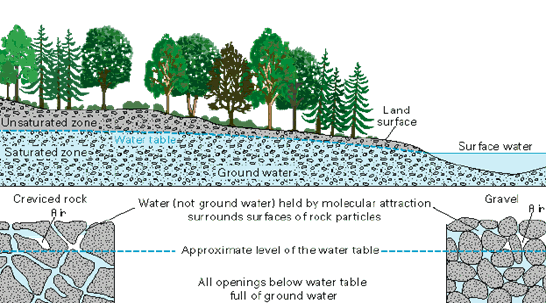|
Aquifers |
|
| Springs
are not only beautiful to look at, but they can also be used to
teach us interesting geological facts.
The water which emerges from a spring and flows with the aid of gravity to creeks comes from aquifers. Webster’s Dictionary defines an aquifer as “a water-bearing stratum of permeable rock, sand, or gravel”. In layman’s terms, an aquifer is a large bed of rock, covering sometimes hundreds of miles, that has the ability to contain water. This is often referred to as “permeability”, and a rock’s permeability is based on how porous a it is, or how much airspace exists between the sediments. Aquifer porosity permits the storing of water for significant amounts of time. Aquifers differ from rocks above and around them by being “saturated”, meaning they are full of water. Other rocks and soils that are “unsaturated” do not have the capacity to store water, and therefore are never full of water. Water either travels through them, or cannot, due to lack of permeability. In the diagram below, you can see how the ground below the water table (the blue area) is saturated with water. The "unsaturated zone" above the water table (the greenish area) still contains water (after all, plants' roots live in this area), but it is not totally saturated with water. You can see this in the two drawings at the bottom of the diagram, which show a close-up of how water is stored in between underground rock particles. Saturated
and Unsaturated Zones Courtesy of USGS Water Science For Schools, http://ga.water.usgs.gov/edu/earthgwaquifer.html
|
|
|
|

